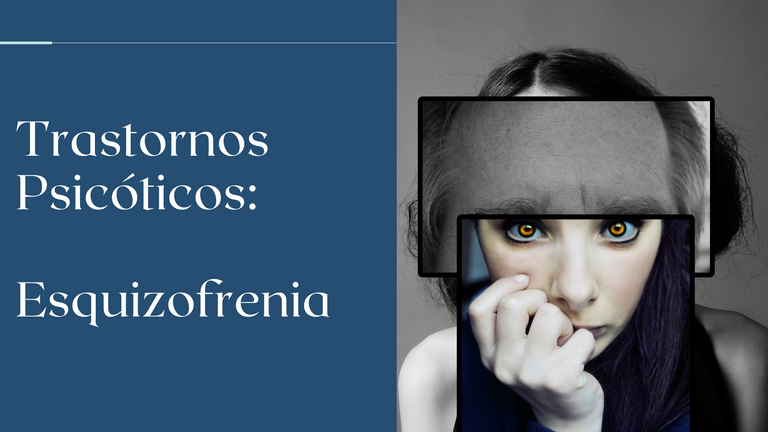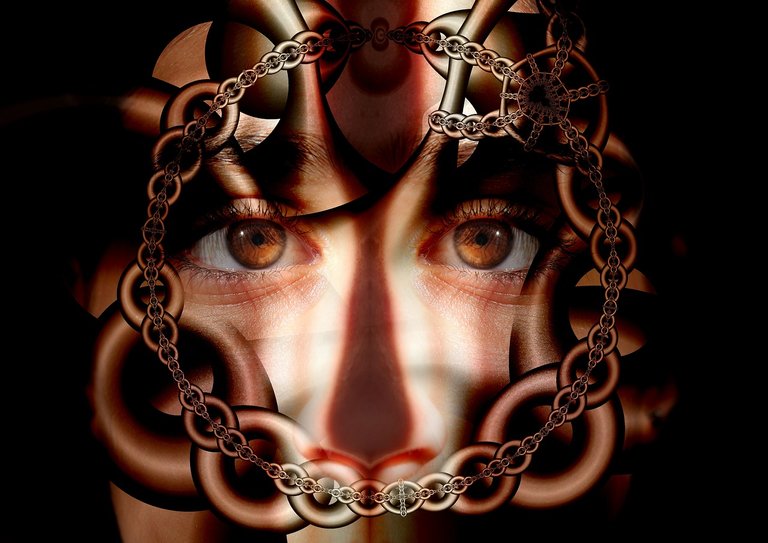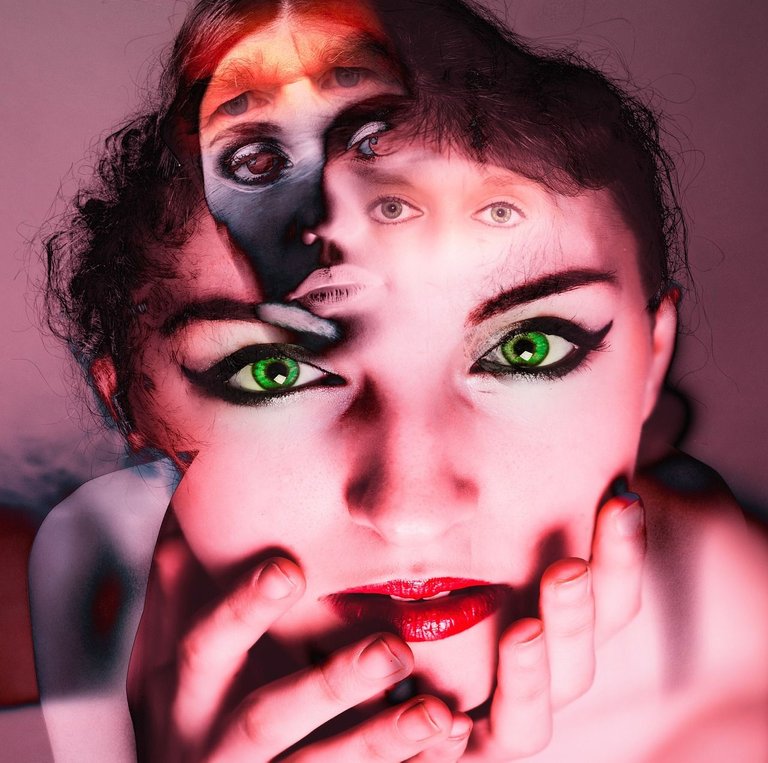Trastornos psicóticos: Esquizofrenia👨🏫-Psychotic Disorders: Schizophrenia👨🏫
Previously in another post I talked about mental health and its individual and social aspects and how it affects us continuously. In this opportunity for my second post I want to tell you when people's mental health is already in its worst stage or when it is practically null and it is the part that these everyday psychological problems that depending on many factors directly affect our mental health widely in our lives and tend to fall into the category of mental illness or mental disorder.
The theme of this occasion will be psychotic disorders and especially one of those that most represents it, which is "Schizophrenia". I want to comment briefly on the definitions, the concepts of the manuals, the theories and how it develops at the individual and social level of these people who suffer from this mental illness.
Si desean ver mi anterior post aquí les dejo el enlace sobre mi publicación sobre la Salud Mental
If you wish to see my previous post here is the link to my publication on Mental Health.

They are those disorders that comply with a series of signs and symptoms that are related to significant alterations in the area of thought, consciousness, orientation, language and perception, which consists of the dissociation of the subjective reality of the mind and its environment, where it is unable to distinguish both spaces and also progressively the patient builds an alternate reality according to his mind. These alterations are mostly characterized by "psychosis" which is a state of disconnection from reality and the absence of awareness of it, presenting itself in various stages of the development of the disorder called "psychotic episodes".
In psychiatry and clinical psychology, there are two manuals that help in the identification, classification and differentiation of each mental disorder according to how it presents itself and the criteria that the patient has. We have the International Statistical Classification of Diseases and Related Health Problems (CIE-10) endorsed by the World Health Organization (WHO) which is the manual of all the classification of human diseases existing so far, placing them by code, in the case of mental illnesses are the codes that begin with the letter "F" and with respect to psychotic disorders are located from the F20
On the other hand we have the Diagnostic and Statistical Manual of Mental Disorders (DSM-V) endorsed by the American Psychiatric Association, which has its own classification of mental illnesses but at the same time based on the initial coding of CIE-10). Both agree and differ in some aspects of the classification of mental disorders, for the purposes of this post we will rely on the information provided by both manuals.
For CIE-10 there are 6 classifications of psychotic disorders ranging from Schizophrenia (F20) and its types (F20.0 to F20.6), Schizotypal Disorders (F21), Persistent Delusional Disorders (F22), Acute Polyphoric Psychotic Disorders (F23), Induced Delusional Disorder (F24) and Schizoaffective Disorder (F25).
In the DSM-V these classifications are reduced to only 3 types of classifications, Schizophrenia as a spectrum, meaning that all types of schizophrenia embodied in the CIE-10 belong to a single spectrum called Schizophrenia. There is the classification of Other Psychotic Disorders and Schizotypal Personality Disorder.
Psychotic disorders, like mental illnesses, have a genetic and biochemical predisposing factor, which requires the administration of psychotropic drugs specifically prescribed by a psychiatric physician for the treatment of negative symptoms and the attendance of psychotherapy to help the patient cope with the mental illness and manage his life while being aware of his disorder.
In psychotic disorders are present some essential characteristics to identify and make the diagnostic evaluation of the patient, according to the way, how they arise and the time between the first and second appearance of the symptoms, plus the development and the positive or negative reaction to psychiatric and psychotherapeutic treatment, will help to determine the diagnosis according to these characteristics:
- Delirios: “Los delirios son ideas fijas que no son susceptibles al cambio a pesar de haber pruebas en su contra de que no es real. Existen varios tipos de delirios: persecutorios, referenciales, somáticos, religiosos, de grandeza” (APA, 2014).
- Delusions: "Delusions are fixed ideas that are not susceptible to change despite evidence to the contrary that they are not real. There are several types of delusions: persecutory, referential, somatic, religious, delusions of grandeur" (APA, 2014).
Persecutory delusions is the idea that one is going to be harmed, harassed, etc., by an individual, organization or group, it is a direct alteration of the thought sphere. Referential delusions is the idea that certain gestures, comments, environmental cues, etc., are directed at one. Delusions of grandeur is when the subject believes that he or she has exceptional abilities, wealth or fame and erotomanic delusions is when the individual mistakenly believes that another person is in love with him or her. Nihilistic delusions involve the conviction that a great catastrophe will happen, and somatic delusions focus on pre-occupations concerning health and organ function (APA, 2014).
- Alucinaciones: Las alucinaciones son percepciones que tienen lugar sin la presencia de un estímulo externo. Son vívidas y claras, con toda la fuerza y el impacto de las percepciones normales, y no están sujetas al control voluntario. No se debe tomar en cuenta las percepciones que tengan lugar en un contexto normal de conciencia, es decir aquellas que se puedan tener al dormir o despertar, o en un contexto religioso cultural (APA, 2014).
- Hallucinations: Hallucinations are perceptions that take place without the presence of an external stimulus. They are vivid and clear, with all the force and impact of normal perceptions, and are not subject to voluntary control. Perceptions that take place in a normal context of consciousness, i.e. those that may be had when sleeping or waking, or in a cultural religious context, should not be taken into account (APA, 2014).
- Discurso desorganizado: Es cuando el individuo cambie de un tema a otro por asociación o descarrilamiento del pensamiento, o dar respuestas que estén relacionadas o no con la pregunta. Si el discurso es tan desorganizado puede confundirse por una afasia (APA, 2014).
-Disorganized speech: This is when the individual switches from one topic to another by association or derailment of thought, or give answers that are related or unrelated to the question. If the speech is so disorganized it can be mistaken for aphasia (APA, 2014).
- El comportamiento motor desorganizado: se puede manifestar de diferentes maneras, desde los movimientos infantiles a la agitación impredecible. Pueden evidenciarse problemas para llevar a cabo cualquier tipo de comportamiento dirigido a un objetivo, con las consiguientes dificultades para realizar las actividades cotidianas (APA, 2014).
- Disorganized motor behavior: can manifest in different ways, from infantile movements to unpredictable agitation. Problems in carrying out any type of goal-directed behavior may be evident, with consequent difficulties in performing daily activities (APA, 2014).
- Síntomas negativos: refieren a la expresión emotiva disminuida y la abulia. La expresión emotiva disminuida consiste en una disminución de la expresión de las emociones mediante la cara, el contacto ocular, a la entonación del habla y los movimientos de las manos, la cabeza y la cara que habitualmente dan un énfasis emotivo al discurso. La abulia es una disminución de las actividades, realizadas por iniciativa propia y motivada por un propósito. (APA, 2014).
- Negative symptoms: refer to diminished emotional expression and abulia. Diminished emotive expression consists of a decrease in the expression of emotions through the face, eye contact, to speech intonation and movements of the hands, head and face that usually give an emotional emphasis to the speech. Abulia is a decrease in activities, performed on one's own initiative and motivated by purpose (APA, 2014).
Schizophrenia is a term used to refer to a disorder by the presence of certain characteristics (described above) such as delusions and hallucinations called positive symptoms, which are phenomena that are not present in the past or in the patient's life history and are identified in the patient's behavior. Negative symptoms are the deterioration of basic and higher cognitive functions and at the same time influence the individual's social behaviors, resulting in a decline in the general aspects of the patient's life. Said by Montaño et al... (2013):
Schizophrenia is a term used to describe a significant and important psychiatric disorder or set of disorders that alters an individual's perception, thinking, affect and behavior, and each person suffering from this disorder has his or her own unique combination of symptoms and experiences as influenced by particular circumstances (pp. 86-87).
It contains a chronic development and varies according to how the symptoms have appeared and how they react to psychiatric and therapeutic treatment. Its diagnostic evaluation begins with the first psychotic episode and from the second episode onwards, within a period of no more than 6 months, it can be inferred that it is a possible case of schizophrenia. The average age at which symptoms begin to appear is from 15 to 30 years old.
The etiology of schizophrenia currently remains a multifactorial effect, because it is not a single factor that causes the person to suffer from the disease, but there are many variables involved for an individual to suffer from schizophrenia, from the developmental theories that suggests that the origin of the disease occurs in the process of brain development; The genetic inheritance theory, which states that the disease is a gene that is inherited depending on the proximity of the patient and his relatives, being the inheritance of two schizophrenic parents with high probability of having descendants with the disease; the environmental theory states that the environment influences in a considerable percentage in the development of the disease due to the place in which it develops psychosocially.
El CIE-10 nos indica que existen varios subtipos de esquizofrenia según el síntoma prevaleciente en el cuadro clínico con o sin síntomas psicóticos:
CIE-10 indicates that there are several subtypes of schizophrenia according to the prevailing symptom in the clinical picture with or without psychotic symptoms:
- Esquizofrenia paranoide
- Esquizofrenia hebefrénica
- Esquizofrenia catatónica
- Esquizofrenia indiferenciada
- Depresión postesquizofrénica
- Esquizofrenia residual
- Esquizofrenia simple
- Paranoid schizophrenia
- Hebephrenic schizophrenia
- Catatonic schizophrenia
- Undifferentiated schizophrenia
- Post-schizophrenic depression
- Residual schizophrenia
- Simple schizophrenia
The DSM-V infers that schizophrenia is a spectrum, encompassing all subtypes specified according to the prevailing symptom in a single term (Schizophrenia).

People suffering from schizophrenia are the focus of marginalization, abandonment and rejection as a result of social ignorance of this disease, and that there is no educated population in mental health and mental illness. Today they are victims of the neglect of the public health system depending on the region, in addition to being 0.1 to 1% of the general population that represents people suffering from this disease.
A society that is not immersed in prevention and responsibility for mental health means that there is no social pressure to represent these patients in government policies. Since the evolution of the disease makes the deterioration of cognitive and behavioral functions progressive by advancing without psychiatric care and impairs the quality of life of patients, it is at this stage where they are more visible to society, but are victims of rejection and discrimination by the very ignorance of the disease. There is no educated society in the prevention of this disorder to avoid its chronic progression in the individual. Without taking into account that the care of these psychiatric treatments are highly expensive and not all patients have the economic, social and family resources to treat their diagnosis in time.

Well my readers of the scientific community, I hope you liked this post and has served as meaningful information. Mental disorders for me as a psychology student are one of my highest curiosities to learn how they work and at the same time how to help people who suffer from them from the individual and social clinic, so I will progressively bring more post about other types of disorders. I would like to know your opinion about this topic, I will be happy to know what you thought about it.
GEJMAN, P. & SANDERS, A. (2012). LA ETIOLOGÍA DE LA ESQUIZOFRENIA. MEDICINA.
Montaño, L., Nieto, T. & Mayorga, N. (2013, 31 julio). ESQUIZOFRENIA y TRATAMIENTOS PSICOLÓGICOS: UNA REVISIÓN TEÓRICA. Revista Vanguardia Psicológica.
Saiz Ruiz, J., de la Vega Sánchez, D. & Sánchez Páez, P. (2010). Bases neurobiológicas de la esquizofrenia. Clínica y Salud. https://10.5093/cl2010v21n3a3
Vallejo Ruiloba, J. (Director). (2015). Introducción a la psicopatología y a la psiquiatría (8.a ed.). A. Parras.
Organización Mundial de la Salud. (2008). Clasificación estadística internacional de enfermedades y problemas relacionados con la salud (10ª ed.). http://www.who.int/classifications/
Asociación Americana de Psiquiatría, Manual diagnóstico y estadístico de los tras-tornos mentales (DSM-5®), 5a Ed. Arlington, VA, Asociación Americana de Psiquiatría, 2014


Congratulations @omarqm! You have completed the following achievement on the Hive blockchain And have been rewarded with New badge(s)
Your next target is to reach 1250 upvotes.
You can view your badges on your board and compare yourself to others in the Ranking
If you no longer want to receive notifications, reply to this comment with the word
STOPCheck out our last posts:
Support the HiveBuzz project. Vote for our proposal!
https://twitter.com/1342920187402715136/status/1607975988708708357
The rewards earned on this comment will go directly to the people sharing the post on Twitter as long as they are registered with @poshtoken. Sign up at https://hiveposh.com.
Does this disorder leads to mental illness most of the time if not controlled?
Thank you for your comment. Any disorder that is not diagnosed and treated for a while tends to worsen to a mental illness. Especially for its various factors that alter the human psyche as genetics and the environment where it develops or the quality of life you have.
Thanks for your contribution to the STEMsocial community. Feel free to join us on discord to get to know the rest of us!
Please consider delegating to the @stemsocial account (85% of the curation rewards are returned).
You may also include @stemsocial as a beneficiary of the rewards of this post to get a stronger support.
Thank you for your support
this is a nice education about mental pathologies!

!1UP
Thanks for commenting! I'm glad you liked it😇
You have received a 1UP from @gwajnberg!
@ccc-curator, @stem-curator
And they will bring !PIZZA 🍕.
Learn more about our delegation service to earn daily rewards. Join the Cartel on Discord.
I gifted $PIZZA slices here:
@curation-cartel(9/20) tipped @omarqm (x1)
Join us in Discord!